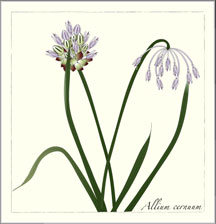Description: This native perennial plant consists of a vase-like rosette of basal leaves. The leaves are about 12" long and up to ¼" across. They are linear in shape, with smooth margins and parallel venation. Unlike many onions from the Old World, the leaves are solid and flat, and there is a small ridge running along their length. They are rather soft and tend to bend outward or downward. From the center of the rosette, a single flowering scape may appear that is about 1½' tall. This scape terminates in an umbel of flowers. This umbel faces toward the ground because the scape bends downward at its apex. The flowers are individually about ¼" long, and may be white, light lavender, or pink. A flower consists of 3 petals and 3 sepals (i.e., tepals) with a similar appearance, and has 6 white stamens with yellow anthers. The pedicels are about ¾"  long. At the base of the umbel are two membraneous bracts that soon fall off. The blooming season is usually mid-summer and lasts about a month. There is no floral scent. The flowers are replaced by seed capsules containing small black seeds that are light in weight and rather flat. They are distributed to a limited extent by the wind. The root system consists of a bulb that is longer than it is wide. Both the bulb and foliage have a typical onion-like scent. Offsets frequently form, creating small clumps of plants.
long. At the base of the umbel are two membraneous bracts that soon fall off. The blooming season is usually mid-summer and lasts about a month. There is no floral scent. The flowers are replaced by seed capsules containing small black seeds that are light in weight and rather flat. They are distributed to a limited extent by the wind. The root system consists of a bulb that is longer than it is wide. Both the bulb and foliage have a typical onion-like scent. Offsets frequently form, creating small clumps of plants.
Cultivation: The preference is full or partial sun, and moist to mesic conditions. The soil can consist of black loam, or contain either rocky or sandy material. This plant resents hot, dry summers. It usually isn't bothered by foliar disease. This plant is easy to grow, and will spread gradually under suitable conditions. It is easier to establish plants by transplants from offsets, rather than by attempting to germinate the seeds.
Range & Habitat: Nodding Onion is an uncommon plant that occurs only in NE Illinois. Habitats include moist to mesic black soil prairies, sandy pannes near dunes, and rocky bluffs. Much of the prairie habitat where this plant once occurred has been destroyed by development. It is more likely to be observed in high quality habitats than disturbed areas.
Faunal Associations: The flowers are pollinated by small short-tongued bees, such as Halictid bees. Syrphid flies may visit the flowers as well, but they are feeding on the pollen and are non-pollinating. Mammalian herbivores usually don't eat Allium spp., although livestock may consume the foliage along with the grass in pastures, which can provide milk with an off-flavor.
Comments: This plant is easy to identify because of the nodding habit of the flowers. Nodding umbels of flowers are an evolutionary adaptation that tends to restrict insect visitors to bees. Other insects are more reluctant to hang upside down while attempting to feed on nectar or pollen. The nodding habit may also protect the nectar from rain. The Nodding Onion is available in the nursery trade, which often features cultivars with rosy pink flowers.